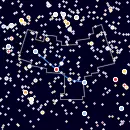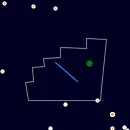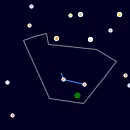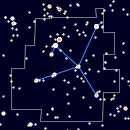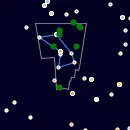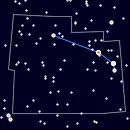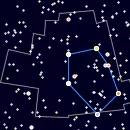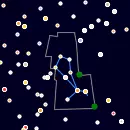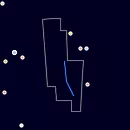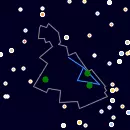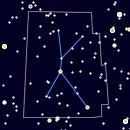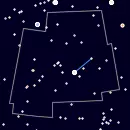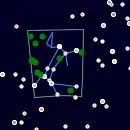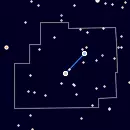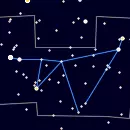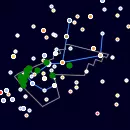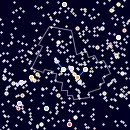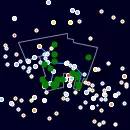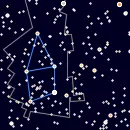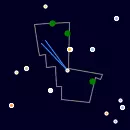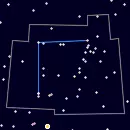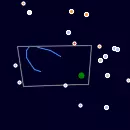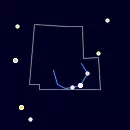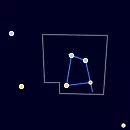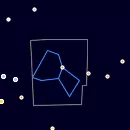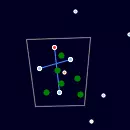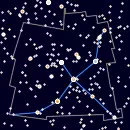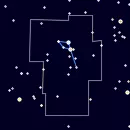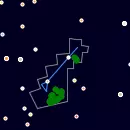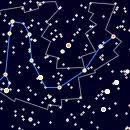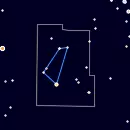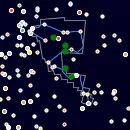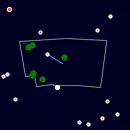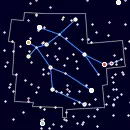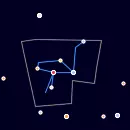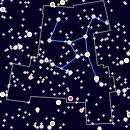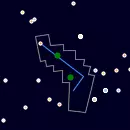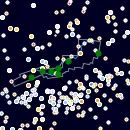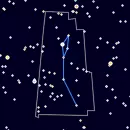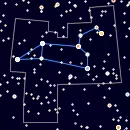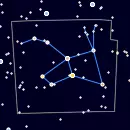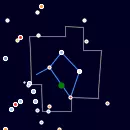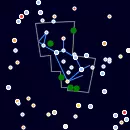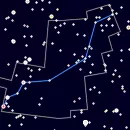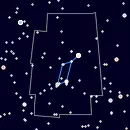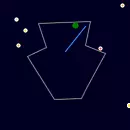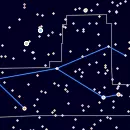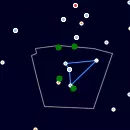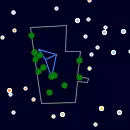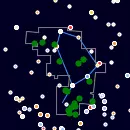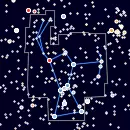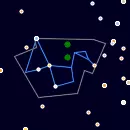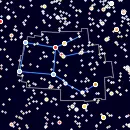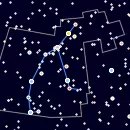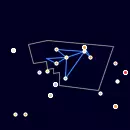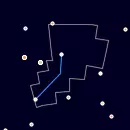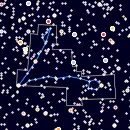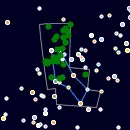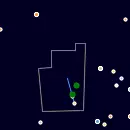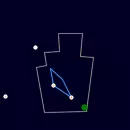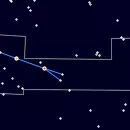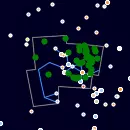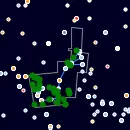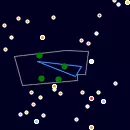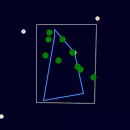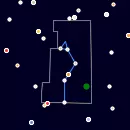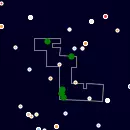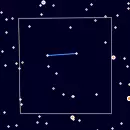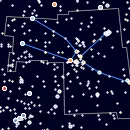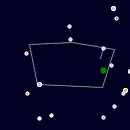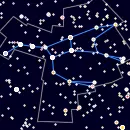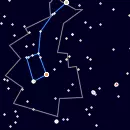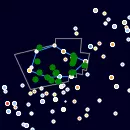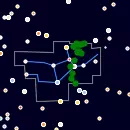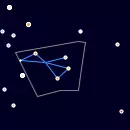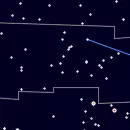Explore the 88 Constellations: Full List of Celestial Patterns
Sky Map
Celectial bearing and elevation at 01:25
Astronomers have divided the sky into 88 official constellations, each with its own distinct identity. From ancient patterns like Orion to lesser-known groups like Camelopardalis, explore the full list of celestial formations that span our skies.
Andromeda
Constellation
Andromeda, named after the mythical princess, is a constellation in the northern sky known for containing the Andromeda Galaxy, the nearest large galaxy to the Milky Way.
Antila
Constellation
Antlia, the air pump, is a faint constellation in the southern sky introduced by the French astronomer Nicolas-Louis de Lacaille.
Apus
Constellation
Apus, the bird of paradise, is a small constellation in the southern hemisphere known for its representation of a bird without feet.
Aquarius
Constellation
Aquarius, the water bearer, is one of the oldest recognized constellations, symbolizing a man pouring water and part of the zodiac.
Aquila
Constellation
Aquila, the eagle, is a constellation in the northern sky, known for its bright star Altair, part of the Summer Triangle asterism.
Ara
Constellation
Ara, the altar, is a southern constellation symbolizing an altar in Greek mythology, located near the constellations Scorpius and Centaurus.
Aries
Constellation
Aries, the ram, is a zodiac constellation located in the northern celestial hemisphere, associated with the story of the Golden Fleece in Greek mythology.
Auriga
Constellation
Auriga, the charioteer, is a constellation in the northern sky with the bright star Capella, one of the brightest stars visible from Earth.
Bootes
Constellation
Boötes, the herdsman, is a northern constellation famous for its bright star Arcturus, the fourth brightest star in the night sky.
Caelum
Constellation
Caelum, the chisel, is a small southern constellation introduced by Nicolas-Louis de Lacaille in the 18th century, representing a chisel or engraving tool.
Camelopardalis
Constellation
Camelopardalis, the giraffe, is a large but faint constellation in the northern sky, representing a giraffe or a camel.
Cancer
Constellation
Cancer, the crab, is a small constellation in the zodiac, known for its dim stars and the open cluster Praesepe, or the Beehive Cluster.
Canes Venatici
Constellation
Canes Venatici, the hunting dogs, is a northern constellation known for its two bright stars, Cor Caroli and Chara, which represent the dogs of the hunter Bootes.
Canis Major
Constellation
Canis Major, the greater dog, is a large and prominent constellation in the southern sky, home to Sirius, the brightest star in the night sky.
Canis Minor
Constellation
Canis Minor, the lesser dog, is a small constellation in the northern sky, containing the bright star Procyon, part of the Winter Triangle asterism.
Capricornus
Constellation
Capricornus, the sea-goat, is a zodiac constellation that is one of the oldest documented constellations, representing a creature that is part goat and part fish.
Carina
Constellation
Carina, the keel, is a southern constellation that was once part of the larger Argo Navis and contains Canopus, the second-brightest star in the sky.
Cassiopeia
Constellation
Cassiopeia, representing a mythical queen, is a W-shaped constellation prominent in the northern sky and easy to recognize due to its unique shape.
Centaurus
Constellation
Centaurus, the centaur, is a prominent constellation in the southern sky containing Alpha Centauri, the closest star system to the Sun.
Cepheus
Constellation
Cepheus, the king, is a northern constellation named after the mythological king Cepheus of Ethiopia. It contains the star Alderamin, part of the northern sky's circumpolar stars.
Cetus
Constellation
Cetus, the sea monster or whale, is a constellation in the celestial equator associated with the Greek myth of Andromeda and Perseus.
Chamaeleon
Constellation
Chamaeleon, the chameleon, is a small constellation in the southern sky named after the lizard, known for its faint stars.
Circinus
Constellation
Circinus, the compass, is a small, faint constellation in the southern hemisphere introduced by Nicolas-Louis de Lacaille in the 18th century.
Columba
Constellation
Columba, the dove, is a small constellation in the southern sky representing a dove, often associated with Noah's Ark.
Coma Berenices
Constellation
Coma Berenices, Berenice's Hair, is a faint constellation representing the hair of Queen Berenice II of Egypt, famous for its star cluster.
Corona Australis
Constellation
Corona Australis, the southern crown, is a small southern constellation resembling a curved line or crown near Sagittarius.
Corona Borealis
Constellation
Corona Borealis, the northern crown, is a small, semicircular constellation in the northern sky, representing the crown of Ariadne.
Corvus
Constellation
Corvus, the crow, is a small constellation representing a crow or raven, located near Virgo and Crater.
Crater
Constellation
Crater, the cup, is a small constellation in the southern sky, representing a cup in Greek mythology, often associated with the god Apollo.
Crux
Constellation
Crux, the Southern Cross, is a small but distinctive constellation in the southern sky, often used for navigation in the Southern Hemisphere.
Cygnus
Constellation
Cygnus, the swan, is a northern constellation with the star Deneb, forming part of the Summer Triangle asterism.
Delphinus
Constellation
Delta, the triangle, is a small constellation in the northern sky. It is named after the Greek letter Delta, resembling a triangular shape.
Dorado
Constellation
Dorado, the dolphinfish, is a southern constellation known for containing part of the Large Magellanic Cloud, a nearby galaxy.
Draco
Constellation
Draco, the dragon, is a northern constellation that winds around the Little Dipper, with its head near Hercules and its tail near Ursa Minor.
Equuleus
Constellation
Equuleus, the little horse, is a small and faint constellation in the northern sky, representing a foal or small horse.
Eridanus
Constellation
Eridanus, the river, is a large constellation representing a river flowing from the foot of Orion towards the southern sky.
Fornax
Constellation
Fornax, the furnace, is a faint southern constellation introduced by Nicolas-Louis de Lacaille to honor the laboratory furnace.
Gemini
Constellation
Gemini, the twins, is a zodiac constellation representing the mythological twins Castor and Pollux. It is known for its bright stars, Castor and Pollux, and its prominent place in the winter sky.
Grus
Constellation
Grus, the crane, is a constellation in the southern sky that represents the bird crane, known for its graceful long neck.
Hercules
Constellation
Hercules, named after the Greek hero, is a northern constellation containing the Hercules Cluster, a globular star cluster visible with binoculars.
Horologium
Constellation
Horologium, the clock, is a faint southern constellation named by Nicolas-Louis de Lacaille to honor timekeeping.
Hydra
Constellation
Hydra, the water snake, is the largest constellation, stretching across the southern and northern hemispheres. It represents a serpent, and its brightest star is Alphard.
Hydrus
Constellation
Hydrus, the water snake, is a southern constellation that represents a small snake in the water, known for containing the bright star Beta Hydri.
Indus
Constellation
Indus, the Indian, is a southern constellation representing a native of the East Indies, introduced by Dutch navigators in the 16th century.
Lacerta
Constellation
Lacerta, the lizard, is a faint northern constellation that represents a lizard and is located between Cygnus and Andromeda.
Leo
Constellation
Leo, the lion, is a zodiac constellation best known for its bright star Regulus and its distinctive backward question mark or sickle shape.
Leo Minor
Constellation
Leo Minor, the smaller lion, is a northern constellation representing a little lion. It contains several faint stars, including Praecipua, and is located between Ursa Major and Leo.
Lepus
Constellation
Lepus, the hare, is a small constellation located south of Orion, representing a hare in Greek mythology.
Libra
Constellation
Libra, the scales, is a zodiac constellation symbolizing balance and fairness, located near the constellations Virgo and Scorpius.
Lupus
Constellation
Lupus, the wolf, is a southern constellation located near Scorpius and Centaurus, representing a wolf in ancient mythology.
Lynx
Constellation
Lynx, the lynx, is a faint northern constellation. Its name refers to the animal known for its sharp sight, symbolizing the challenge of finding its dim stars.
Lyra
Constellation
Lyra, the lyre, is a small but prominent constellation featuring the bright star Vega, one of the brightest stars in the night sky.
Mensa
Constellation
Mensa, the table, is a faint southern constellation named after Table Mountain in South Africa by Nicolas-Louis de Lacaille.
Microscopium
Constellation
Microscopium, the microscope, is a faint constellation in the southern sky introduced by Nicolas-Louis de Lacaille in the 18th century.
Monoceros
Constellation
Monoceros, the unicorn, is a faint constellation located near Orion, known for containing several star clusters and nebulae.
Musca
Constellation
Musca, the fly, is a small constellation in the southern sky representing a fly, introduced in the 16th century by Dutch navigators.
Norma
Constellation
Norma, the square, is a small, faint constellation in the southern hemisphere representing a carpenter's square.
Octans
Constellation
Octans, the octant, is a faint constellation in the southern sky, known for containing the south celestial pole star, Sigma Octantis.
Ophiuchus
Constellation
Ophiuchus, the serpent-bearer, is a large constellation in the southern sky, representing a man holding a serpent, often associated with healing.
Orion
Constellation
Orion, the hunter, is a famous constellation with distinctive stars, including Betelgeuse and Rigel, and the Orion Nebula.
Pavo
Constellation
Pavo, the peacock, is a southern constellation representing a peacock, known for its bright star Peacock (Alpha Pavonis).
Pegasus
Constellation
Pegasus, the winged horse, is a constellation featuring the Great Square of Pegasus, which is used to locate nearby constellations like Andromeda.
Perseus
Constellation
Perseus, named after the Greek hero, is a constellation known for the Perseid meteor shower and the star Algol, also called the Demon Star.
Phoenix
Constellation
Phoenix, the mythical bird, is a southern constellation named after the phoenix, symbolizing rebirth and immortality, and is located near the south celestial pole.
Pictor
Constellation
Pictor, the painter’s easel, is a small, faint southern constellation introduced by Nicolas-Louis de Lacaille to honor artists.
Pisces
Constellation
Pisces, the fish, is a zodiac constellation representing two fish tied together by their tails and is associated with the Greek myth of Aphrodite and Eros.
Pisces Austrinus
Constellation
Piscis Austrinus, the southern fish, is a southern constellation representing a fish, with its bright star Fomalhaut.
Puppis
Constellation
Puppis, the stern, is a southern constellation that represents the stern of a ship, once part of the larger constellation Argo Navis.
Pyxis
Constellation
Pyxis, the compass, is a faint southern constellation named by Nicolas-Louis de Lacaille, representing a compass on a ship's navigation tool.
Reticulum
Constellation
Reticulum, the reticle, is a small and faint constellation in the southern sky representing a crosshair, used for sighting astronomical objects.
Sagitta
Constellation
Sagitta, the arrow, is a small northern constellation known for containing the asterism called the Arrow, often associated with the Greek myth of Apollo.
Sagittarius
Constellation
Sagittarius, the archer, is a constellation symbolized by a centaur holding a bow and arrow, notable for pointing toward the center of the Milky Way galaxy.
Scorpius
Constellation
Scorpius, the scorpion, is a prominent constellation of the zodiac, home to the red supergiant star Antares and known for its scorpion shape.
Sculptor
Constellation
Sculptor, the sculptor's workshop, is a faint southern constellation introduced by Nicolas-Louis de Lacaille in honor of sculpture.
Scutum
Constellation
Scutum, the shield, is a small northern constellation representing a shield, associated with the Polish king John III Sobieski's victory over the Ottoman Empire.
Serpens
Constellation
Serpens, the serpent, is a constellation split into two parts, Serpens Caput (the head) and Serpens Cauda (the tail), representing a serpent held by the healer Ophiuchus.
Serpens2
Constellation
Serpens Cauda, the tail of the serpent, is the part of the Serpens constellation representing the tail of the serpent, located near the constellation Ophiuchus.
Sextans
Constellation
Sextans, the sextant, is a faint constellation in the equatorial region, representing a navigation instrument used by astronomers.
Taurus
Constellation
Taurus, the bull, is a zodiac constellation containing the Pleiades and Hyades star clusters and the bright star Aldebaran.
Telescopium
Constellation
Telescopium, the telescope, is a faint constellation in the southern sky, named in honor of the scientific instrument.
Triangulum
Constellation
Triangulum, the triangle, is a small constellation in the northern sky known for containing the Triangulum Galaxy (M33), a member of the Local Group.
Triangulum Australe
Constellation
Triangulum, the triangle, is a small northern constellation known for its triangular shape, containing the Triangulum Galaxy (M33), a member of the Local Group.
Tucana
Constellation
Tucana, the toucan, is a southern constellation containing the Small Magellanic Cloud, a nearby dwarf galaxy.
Ursa Major
Constellation
Ursa Major, the great bear, is a prominent constellation best known for containing the Big Dipper asterism, which is used to locate Polaris, the North Star.
Ursa Minor
Constellation
Ursa Minor, the little bear, contains the Little Dipper asterism and Polaris, the current North Star.
Vela
Constellation
Vela, the sails, is a southern constellation that was once part of Argo Navis, representing the sails of a ship.
Virgo
Constellation
Virgo, the maiden, is a large zodiac constellation associated with the goddess of fertility and agriculture, known for containing the bright star Spica.
Volans
Constellation
Volans, the flying fish, is a faint constellation in the southern hemisphere representing a fish that can leap out of the water.
Vulpecula
Constellation
Vulpecula, the little fox, is a faint constellation in the northern sky, introduced in the 17th century by the Polish astronomer Johannes Hevelius.
Acknowledgements
We gratefully acknowledge the International Astronomical Union (IAU) for defining and standardizing the official constellation boundaries, which provide a consistent framework for celestial mapping.
Special thanks to Sky & Telescope Magazine and contributors Roger Sinnott and Rick Fienberg for their collaboration in producing the charts and tables. The constellation patterns, drawn by Alan MacRobert, were influenced by the work of H. A. Rey and thoughtfully adjusted to align with earlier traditions.

